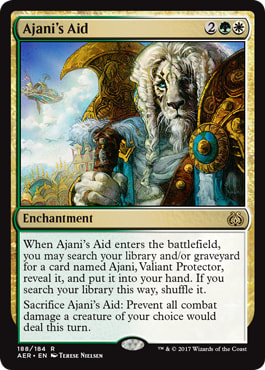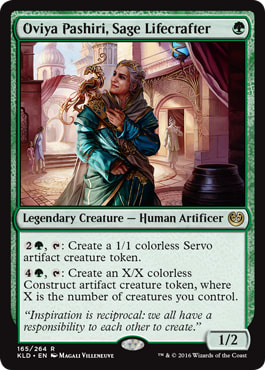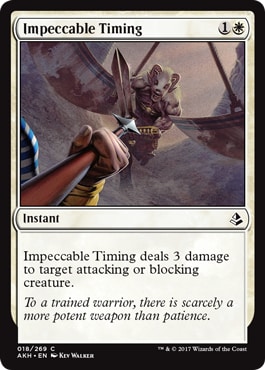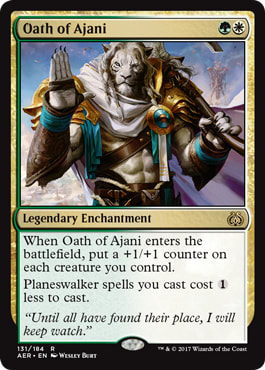I'm not exaggerating when I say that "Release," the Ajani-centric Kaladesh story ending with the rescue of Chandra, Mrs. Pashiri, and Nissa, got me back into Magic's storyline. I mean, I never stopped following the storyline, not really, but I only kept up at a distance, checking out the spoilers for new sets and occasionally poking my head into forums to see what the latest hubbub was. I couldn't tell you now why I even happened to pick up the story to begin with, though I imagine it was probably the positive buzz on Twitter and Tumblr.
It is, after all, a very, very good story.
A lot of that comes from just the quality of writing alone. The opening line is a delight, immediately taking on a slightly defensive tone: "He was still getting used to the hands. That's why he almost fell off the final roof." Ajani is making excuses for himself. Starting the story off this way, and weaving that sense of subtle humor throughout (though, admittedly, there's nothing really subtle about everyone's favorite elf revolutionary Shadowblayde) humanizes Ajani from the outset, makes him more than the cardboard cutout of a brooding hero that he otherwise might be.
And yeah, yeah, "humanize" might not be the best word to apply to a huge furry tiger man, but you work with the language you've got.
Which author Chris L'Etoile does admirably, actually. The whole first part of the story subtly signals the identity of the unnamed and thinly described viewpoint character, leaning heavily on a sense of difference, of this character's nonhuman nature. We learn a lot about Ajani's state of mind from this opening, very little of it through exposition interestingly, but this section, and the story as a whole, underscores a deeper, and more important point: the Multiverse of Dominia is wide, and diverse, and interconnected.
There's an inherent risk in connecting Mrs. Pashiri to Ajani to Tamiyo, Tamiyo to Narset and to a small Nezumi village once burned as part of an interplanar strong-arming. Such connections risk making Dominia seem small, trivial, all the major players knowing each other, each plane a tiny little fishbowl.
And yet, it doesn't really feel that way to me. Why is that?
To a large extent I think it's Nashi's perspective that makes the difference. The introduction of Nashi, a Nezumi child from the village burned by the Infinite Consortium way, way back in 2009, as a viewpoint character flips the narrative largely on its head.
The problem with an overarching narrative like the one WotC is trying to build with the Gatewatch is that such characters inherently have the potential to wrap and warp the plot around themselves. This is ok to an extent — arguably it's part of the genre's origins with heroic myth, and it'd probably be fair to defend the narrative-warping potential of heroes on those grounds. But at the same time, there's something kind of skeevy, I think, about the way that things like morality and empathy can also become warped by the gravity of the Fantasy (Super)Hero, the way that just by virtue of being the hero, a character's atrocities can be forgiven, and the way that other characters can find themselves reduced to NPCs who exist only as a reflection of the Hero's story.
This kind of warping is fine for your average paperback or superhero film . . . or, well, it's not fine, not to me at least, but it's at least understandable that the constraints of narrative space tend to lead to these decisions. In shared world fiction spanning an infinite multiverse, conveyed in serialized short stories, cards, art guides, and who knows what else, though, it's a problem.
Consider if we followed the scenes on Kamigawa from Ajani's perspective, centering his interior thoughts. In that context, loads of stuff in this sequence would just sort of end up revolving around Ajani's mental state. Which, to an extent, they do anyway — this is a narrative ABOUT Ajani's grief and recovery, in some sense.
But centering a Nezumi kid takes all that stuff and makes it a reflection of this random side character's own grief, trauma, and recovery. Rather than Kamigawa, and Tamiyo, and Noshi serving as quest checkpoints, sending The Hero off to his next Heroic Adventure, they are treated as though they matter in their own right. So while the mechanics of the connection threaten to make the Multiverse seem small and cardboard, the actual literary decision to view everything through Noshi's perspective takes what we think of as the main plotline and positions it as a side story for this one random Nezumi.
It feels like this matters, because it's treated like it matters.
It's kind of wild that a story so critical to making Kaladesh feel like a meaningful place isn't a story that received the seal of Storyline Importance. There's much to be said about these story moments and whether or not they're working quite the way WotC wants them to, but not in this article. It's just sort of funny that Impeccable Timing, despite being a pretty critical story moment, isn't, apparently, critical enough to warrant the Planeswalker symbol.
That might be fitting in a weird way, though. This story is only barely about Kaladesh. It's about Kaladesh roughly as much as it's about Kamigawa, or about Ajani's grief, or recapping the events of Theros, or Nashi's backstory. Ajani springs into the story almost from out of nowhere, a sudden, shocking swerve that in a novel would be difficult to pull off, but which a serialized narrative of short, self-contained stories can accommodate a little easier. Even the title is a little odd. Release is certainly a theme woven through Ajani's narrative, literally and figuratively, but of equal importance and weight is Tamiyo's line: "Sometimes people like us . . . forget how big our feet are." So, it's a story that sits oddly within the overarching narrative of Kaladesh.
I would argue, though, that this is what makes it so vital. It's not just that this story provides a wider context in the sense of Tezzeret's scheming and Bolas's long term plans. It does that, to be sure, but it does something more: it suggests a connection between the people of Kaladesh and Kamigawa, and underscores the fact that the conflict between the Gatewatch and Bolas has real weight to it, in the form of the people on these different worlds just trying to live their lives. It portrays these "NPCs" as though they really do matter in their own right, which is critical to highlight given how easy it would be (how easy it arguably is in places) for the Kaladesh storyline to revolve purely around Chandra's perspective, with the whole plane mattering only in relationship to her trauma and anger, the rebellion justified solely because it's what she wants. This story, and stories like those centered on Yahenni, do vital work to broaden the scope, to make the Revolt mean something outside of the perspective of the Hero.
For this reason, Yahenni's stories, and this story, have ended up being the real standouts of Kaladesh Block for me, even though they swerve surprisingly at times away from the main plotline — or rather, because they take those swerves.
Within all this I think it's important to recognize that what makes all this possible, what makes these settings and characters feel real, is enabled by stuff that has in recent years been treated as trivial, as optional, or even as an active hindrance to WotC Telling The Stories They Want To Tell. It's worth really assessing all the things here that lend themselves to this story's sense of weight, and its sense of verisimilitude.
For example, nothing adds to the sense of verisimilitude like all the characters who keep commenting on Ajani's muscles. I mean hot damn.
But there's other important aspects beyond this, and beyond the use of literary techniques that highlight Ajani's nonhuman nature, or the subjective importance of Noshi's trauma.
I'm talking about Continuity.
I'm picturing at least some part of the fandom flinching back at this word like Bela Lugosi reacting to a cross. I can actually picture some of the people at WotC doing this, too, for that matter. Certainly continuity around the time of Origins was being treated pretty ambivalently, often as a hindrance more than anything. And as someone who cares very much about continuity, that marked pretty much the low point in my 17 year obsession with the storyline.
Yikes I'm old.
This story is only possible because of a huge raft of continuity that mostly predates the current player base. No, really. It's hard to get statistics on the player base, or to know how much Hasbro's books might be cooked when it comes to the numbers they've released, but based on what statistics I can find, and based on my own anecdotal observation, a huge swath of the fanbase seems to have arrived after Zendikar.
Among the pieces of continuity from before that period are:
- Agents of Artifice
- Alara and Ajani's storyline there
- Kamigawa
- Elspeth's backstory
- Tezzeret's backstory
- Test of Metal, and Tezzeret's resurrection
- The Purifying Fire
That's a pretty considerable swath of material, and I think a perspective on the storyline that cares only about the accessibility of information would say this is way too much backstory. Such a view would toss out Noshi's place in the narrative, I think.
But by treating these stories as though they matter, L'Etoile and the Creative Team more broadly give a weight and a meaning to THIS story as well, and the choices Ajani makes over its course. This is a story, in large part, about actions having consequences, about Planeswalkers having the potential to do great harm and great good on the planes they travel to, and of those planes having a history that also matters, a history where the burning of a Nezumi village by a gang of Planeswalker thugs has ripples and consequences across a whole area.
What I miss, when continuity is treated as ultra-flexible, as a barrier to each new story, is that sense of history and consequence. Each story becomes weirdly split off from the others, with the characters and settings warping and bending to meet the needs of the designated heroes (or the needs of the most casual audience, perhaps). It's hard for me to feel much empathy for the people of Ravnica or Innistrad or Zendikar or Mirrodin when a return might — probably will — bring changes that treat the struggles, successes, and failures of the past as trivially reversible, and when worlds are only as large as necessary to contain the latest Gatewatch adventure. It's not a kind of world-building I find particularly compelling. To put it politely.
"Release" demonstrated for me that there's still a place in the storyline for consequence, for meaning, for history, and for perspectives that exist outside of the current block's protagonist. It artfully takes up a whole swath of storyline history to reframe the stories of characters like Ajani, Tezzeret, and Jace as mattering not just because it shaped them, but because it shaped characters like Noshi as well. It gives us a glimpse of an infinite multiverse that really does have an endless number of possible stories, about a huge range of characters, human and nonhuman, stories that keep going even after the main characters planeswalk away.
If these stories are to matter, their worlds and their histories have to be treated like they matter, too, to more than just the Heroes.






























